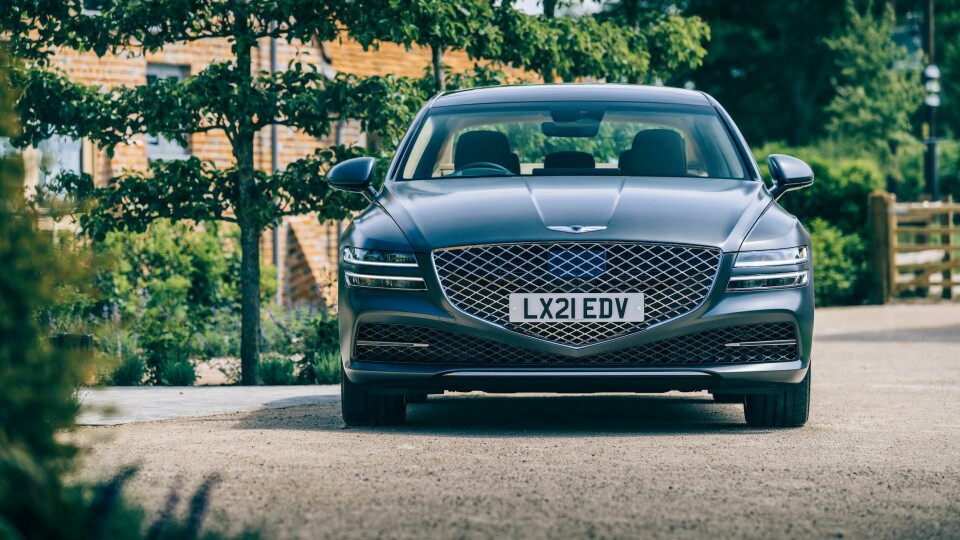
Design review: Genesis G80
Michael Nash falls in love with the shape of the Genesis G80 but finds the user experience quite frustrating
Without spending time in North America or South Korea, you would be forgiven for not yet knowing the Genesis car brand – the luxury arm of Hyundai. The company started its foray into Europe in May 2021 with two models – the G80 sedan and the GV80 SUV. The goal was to bring Korean luxury and a unique driving experience to a new market. Has the newcomer succeeded, and will it become a staple marque in Europe’s car world? We got behind the wheel of the G80 to find out.
The Genesis G80 is somewhat of a shapeshifter. At a first glance, the lengthy sedan is unassuming and subtle, practically going unnoticed when in a busy street full of cars. Its shape and stance are sharp without being dominating, but it doesn’t take long to realise there is something a little special going on here. Proportionally, Genesis have got it spot on with the G80. The long bonnet with the A-pillars pushed back and the overhang at the rear – it’s all very pleasing, and it means that the model looks sumptuous from every angle despite the fact it doesn’t scream “look at me!”
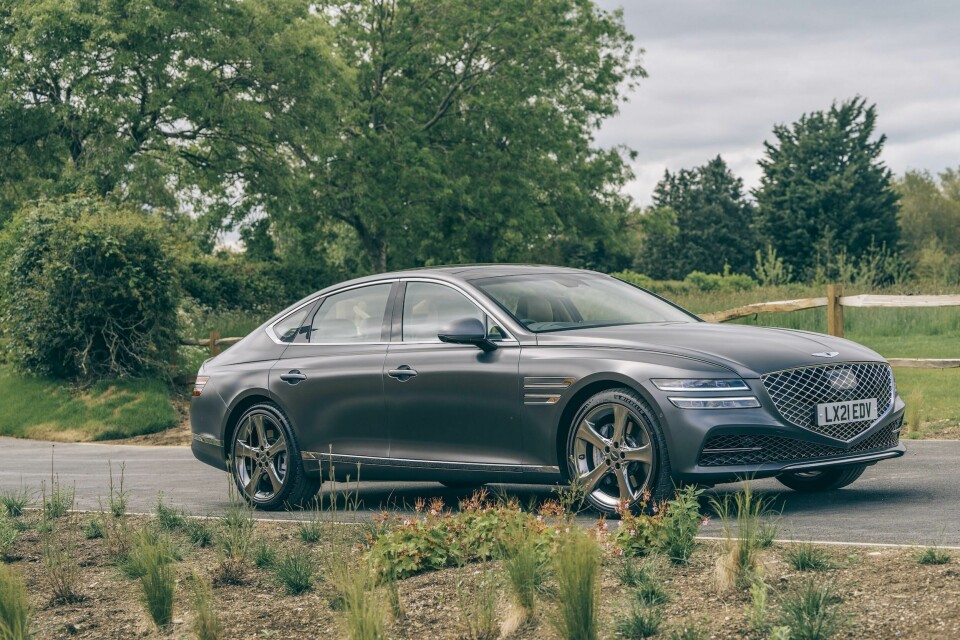
At the front, the giant Genesis diamond-shaped grille features a simple diagonal mesh design. It’s outlined and embossed by a narrow piece of angular body work, like a coat of arms. Either side of the grille sit the dual headlamps, simple in their design with two elongated rectangles stacked one above the other. They wrap around the body work to finish just before the front wheels. Beneath the grille and lamps is a large, wing-shaped air intake that stretches the entire width of the front end, with two needle-like points of metal extending from the bumper. Half of the narrow bumper beneath the air intake is finished in chrome at the centre, adding to the general symmetry.
The headlamps sit very low due to separation of the front fender and the raised bonnet, created by lines extending from the A-pillars and the rear lights. The bonnet slopes gently towards the Genesis badge and the top of the diamond grille. It seems so long and large due to the position of the headlamps and the size of the grille, as well as the various lines and creases.
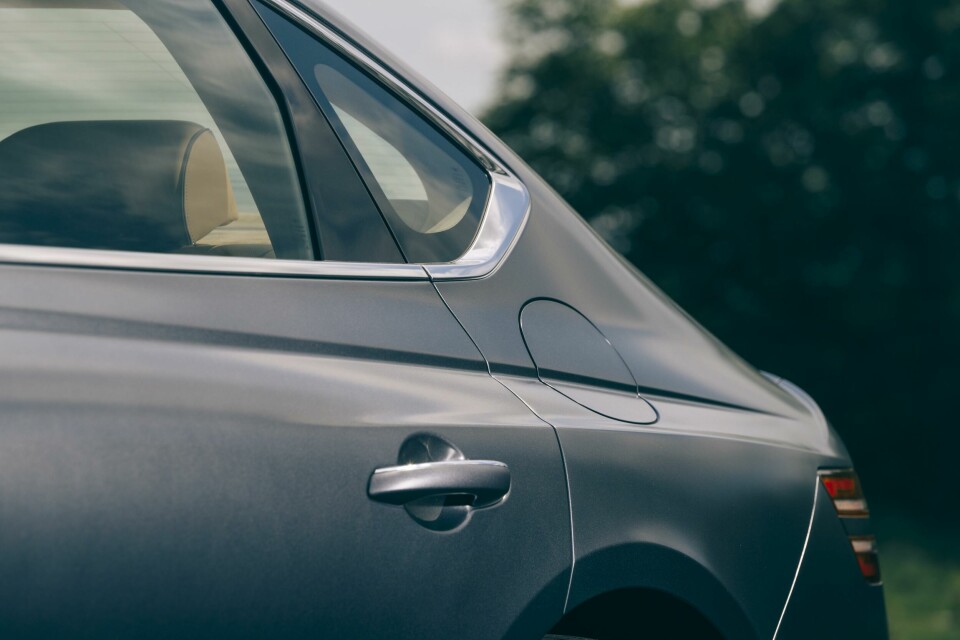
From the side, the length of the bonnet can be seen in full. It is accentuated by shoulder and belt lines, which fade in the centre of the car before reappearing above the rear wheels. Two chrome inserts are placed on the front fender, mimicking the shape and position of the headlamps. A chrome strip separates the door panels from the skirts and rises up at the rear to reflect the downwards slope of the roof.
Slipping into the driving seat, the refinement of the cabin is immediately apparent with high quality materials covering each and every surface
This slope is substantial, extending all the way to a small ducktail spoiler and allowing for a large back window. It makes the back of the G80 almost 911-esque. Below are the rear lights, taking the same rectangular shape as the headlamps, which start on the boot lid and wrap around the rear fenders. Lower down, the chrome strip that features on the sides of the car continues beyond the rear wheels before resulting in reflectors. These sit just above the chunky exhaust outlets, finished in chrome.
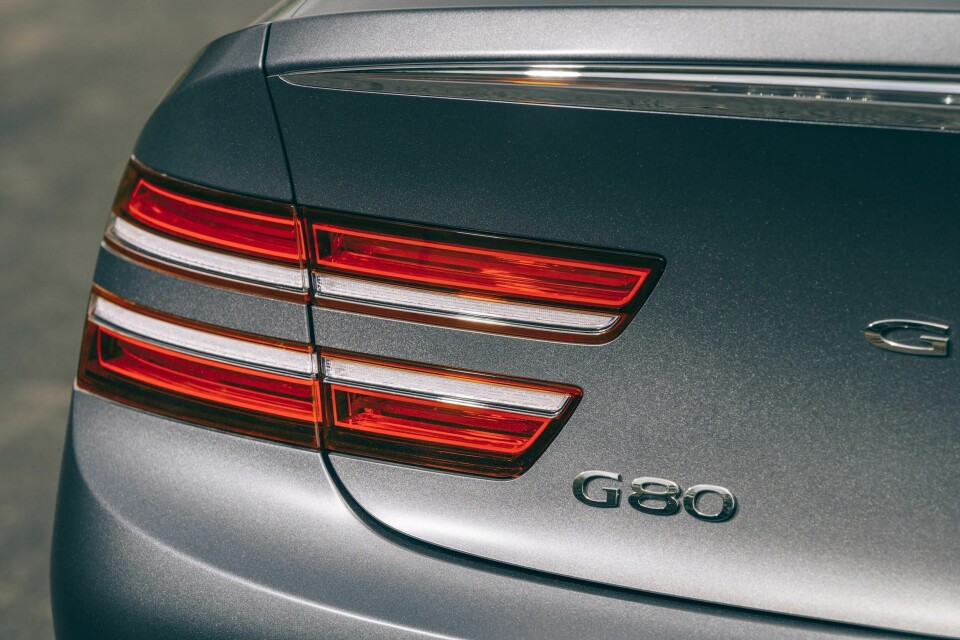
In keeping with the clean exterior, the interior design team opted for a minimal approach with little in the way of clutter. There is also a distinct sense of luxuriousness – one that Genesis champions as a brand differentiator. Slipping into the driving seat, the refinement of the cabin is immediately apparent with high quality materials covering each and every surface. There is little in the way of hard plastics here.
A horizontal IP consists of three layers: the upper dark grey shelf is cladded in leather, the centre houses the hidden air vents with a wooden veneer section, and the lower includes the glove compartment and a small screen for climate controls. The large upper shelf is almost completely unadorned apart from the narrow flat screen that is tucked inside a shallow groove.
The digital driver cluster, controlled by the buttons and wheels on the steering wheel, is less fancy and more functional
There is also a narrow sill, finished in the same dark grey as the upper section of the IP, that hugs the windscreen and connects to the top of the door panels on either side to create a cocooning sensation for the front occupants. The upper half of the doors are also finished in dark grey leather, with the lower half in the same cream as the lower section of the IP and the seats. Wooden veneer inserts in the upper section of the doors provide a cohesive theme to the cabin, positioned at the same level as the chrome handles and small speakers, with the larger bass speakers below.
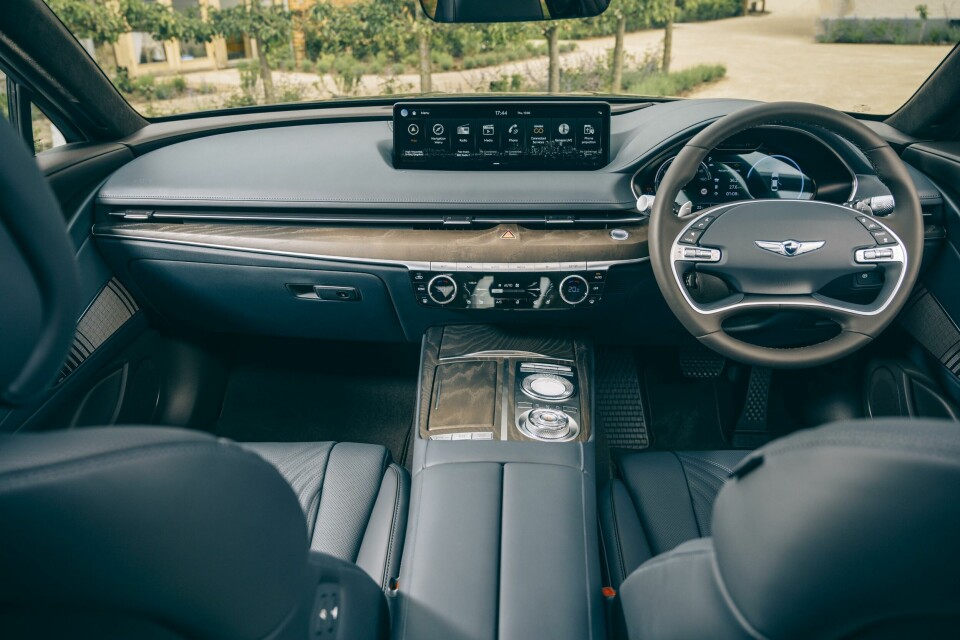
Two storage compartments are featured on the centre console, the smaller of which is tucked away underneath the climate control screen and includes a wireless smartphone charging pad. It can be covered with a simple sliding surface. In contrast, the large storage compartment that doubles up as an armrest for the front occupants is a bit trickier to open – after pressing and prising without luck, I located a hidden button that opens the two leather panels upwards. It’s a frustrating design for new occupants of the car but allows you to feel smug when demonstrating how it’s done to flustered victims.
Speaking of frustration, it would be remiss of me not to mention the user interface. The system is easy to use for the most part. The central screen can be interacted with through the large circular controller located on the centre console above the circular driving mode selector, the former embedded and the latter protruding. It benefits from sharp graphics and a clean design orientated around the main three-page menu. The digital driver cluster, on the other hand, is controlled by the buttons and wheels on the steering wheel. It is less fancy and more functional, with no theatrical graphics and settings like the central screen.
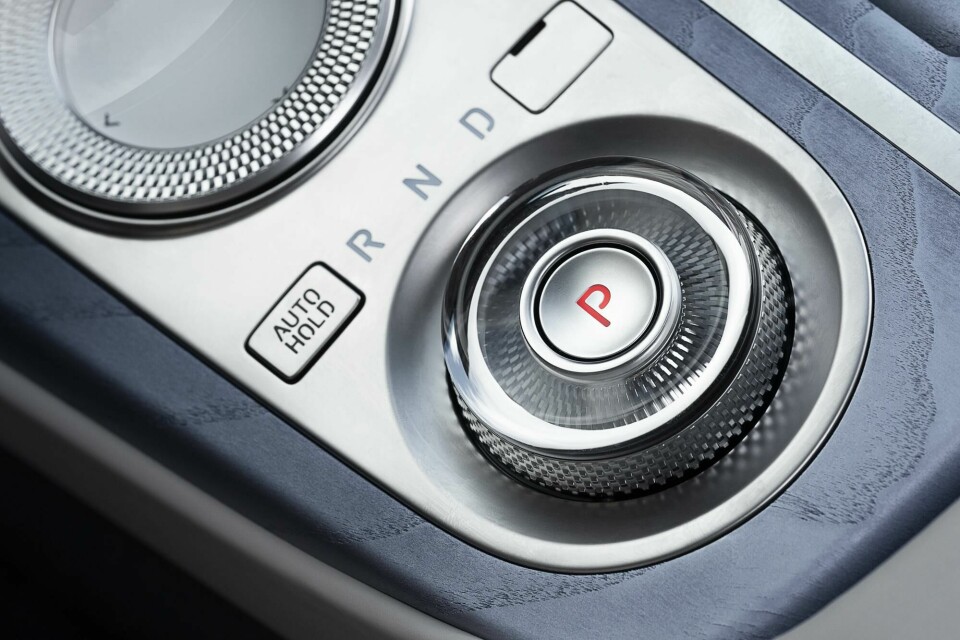
The problems started to emerge when I reached a long stretch of motorway full of speed cameras. In order to prevent the driver from getting a substantial fine through the post, the system beeps long before a camera, giving plenty of warning and ensuring you can slow down if you are being naughty. But the system will continue to beep incessantly until the camera has passed, even when the advanced cruise control (ACC) system is set to 70mph and, due to a slight decline in the road, the car sticks at 71mph.
But this shouldn’t be a problem – there are two easy fixes, right? The first being deactivation of the warning system, and the second being set the ACC to 69mph. However, the warning beep for speed cameras does not come with an accompanying graphic, making it very difficult to decipher why the noise is sounding. Only after hours of driving and the systematic switching off of each and every assistance system, of which there are many, did I finally figure out it was a speed camera warning. Simply turning off the speed camera alert under the driver assistance systems menu was not enough, though. Somehow the persistent, and at this point, downright irritating beep kept sounding. I had to also go into the general settings menu and turn off audio alerts.
The Genesis G80 was a joy to drive, even making the six-hour trip to the Lake District, with storm Eunice kicking up a fuss, feel like a breeze
And then there is the disconnect between the driver cluster and the central screen. Buttons on the steering wheel can be used to scroll through the driver cluster menu and select assistance systems, despite the fact that changes can only be made via the central screen. It seems odd that the settings cannot be altered on the driver cluster, especially when considering that it is a driver-centric function and has nothing to do with the passengers.
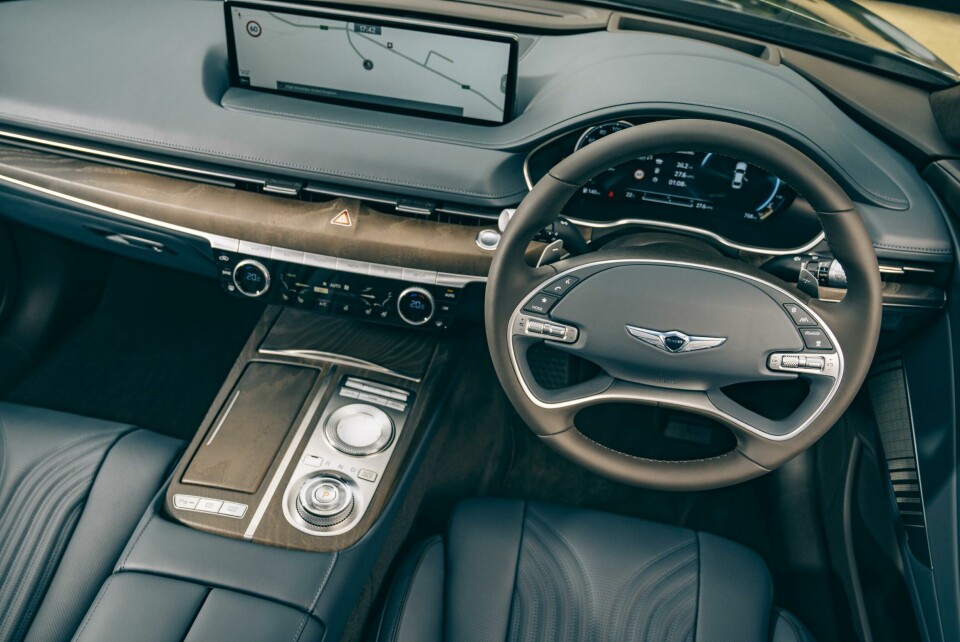
With the speed camera alert successfully muted, the Genesis G80 quickly became a joy to drive, even making the six-hour trip to the Lake District, with storm Eunice kicking up a fuss, feel like a breeze. The ride is extremely smooth and comfortable, and noise in the cabin from wind and tyres is well muffled. Its size and roominess make the sedan particularly well-suited to motorway cruising, although it certainly holds its own on windy country roads too.
Europe’s luxury car market is undeniably inundated with models. To capture a competitive portion, Genesis must clearly offer something different while simultaneously catering to the needs and wants of a tricky target customer. The G80 feels like a strong start, and we will soon test the company’s flagship GV80. But we suspect the all-electric GV60 could be the golden ticket.



